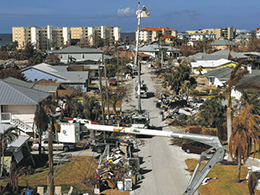
STORM SURGE
Linemen who have seen Mother Nature at her worst couldn't believe their eyes in the aftermath of Hurricane Ian.
Entire neighborhoods on barrier islands gone, washed into the Gulf Coast of Florida by Ian's epic storm surge. Homes and shops and restaurants leveled by 150 mph winds or devoured by floodwaters. Cars and boats scattered and smashed as if a giant toy box had fallen from the sky.
"I've worked quite a few storms, but this last one, I've never seen devastation like it," said Kellen Lewis of West Palm Beach Local 1191, describing the scene on Estero Island, home to Fort Myers Beach. "The pictures don't do it justice. You have to see it in person to really grasp what happened there."
Ian slammed into southwestern Florida just shy of a Category 5 hurricane the afternoon of Sept. 28, making its way to the Carolinas two days later, weaker but still vicious. With more than 100 people confirmed dead, it was Florida's most lethal storm in 90 years and the nation's second-deadliest this century, after Hurricane Katrina in 2005.
The storm cut power to at least 2 million customers, drawing more than 46,000 utility workers from at least 33 states to Florida and another 12,000 to the Carolinas and Virginia, the Edison Electric Institute reported.
They worked to exhaustion 16 hours a day, seven days a week, wading into the nastiest of muck in the stickiest of air, catching what shuteye they could in bunk beds or hammocks or wounded hotels.
Among the IBEW stalwarts were Floridians who'd been dealt as much misery as their neighbors.
"We had members who lost their homes or had extensive damage, up to four feet of water," said Jack Wilson, business manager at Utility System Council 4 in Florida. "They went in and stripped the drywall and interior so their homes could dry out, and then they went to work to help everyone else."  |
 Print
Print  Email
Email
